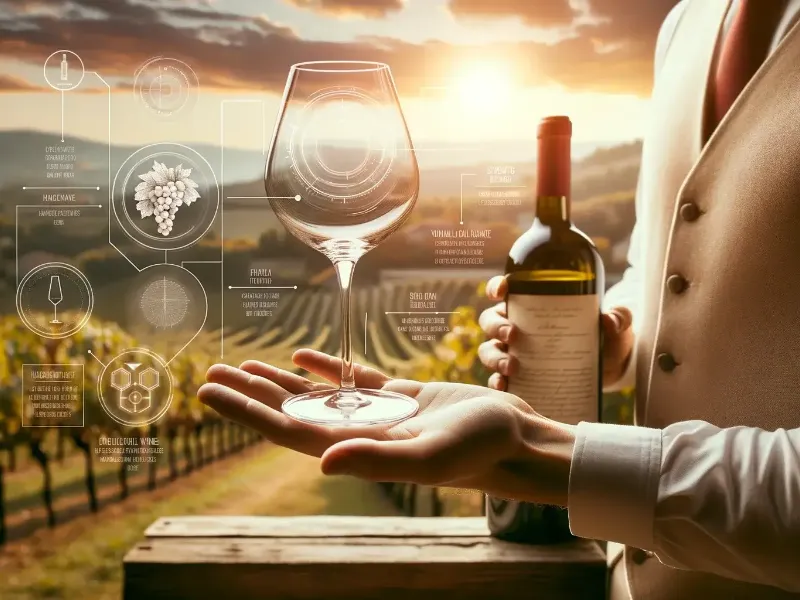There's an often overlooked factor that can greatly enhance your Italian wine drinking experience: the glass. Each type of wine is best enjoyed when served in a glass that's designed to highlight its unique qualities. Let's delve deeper into the world of wine glasses.
Red Wine Glasses
The colour and depth of red wines are best showcased in glasses with a larger, rounder bowl, which also allows the aromas to diffuse and be appreciated. There are two main types of glasses for red wines:
Riedel Vinum Bordeaux Wine Glass, Set of 2
Lead crystal, ideal for Bordeaux, Cabernet. 22.5 cm, 610 ml capacity.
Read more
Crystalex Tulip Stem Wine Glasses, Set of 6
Hand-blown, lead-free crystal glasses. Perfect for any occasion, 550ml.
Read more
Spiegelau Definition Bordeaux Wine Glasses, Set of 2
European-made, lead-free crystal. Dishwasher safe, holds 26 ounces.
Read more
Schott Zwiesel Pure Burgundy Wine Glasses, Set of 2
Tritan crystal, perfect for Burgundy wines. Elegant design, 692ml.
Read more
Bordeaux Glass
This glass has a tall, broad bowl, ideal for full-bodied, heavy reds like Italian Barolo or Amarone. The design allows the wine to breathe and directs it to the back of the mouth, enhancing the perception of depth and complexity.
Burgundy Glass
With its broader bowl and more delicate rim, the Burgundy glass is better suited to more delicate, aromatic reds like Chianti. The wide bowl maximises the surface area of the wine exposed to air, allowing the bouquet to fully bloom.
White Wine Glasses
White wines generally require a more upright, U-shaped glass, which allows the aromas to be released while also maintaining a cooler temperature. Two typical glasses for white wines are:
Chardonnay Glass
This glass falls somewhere between the Bordeaux and Burgundy glasses in size, concentrating the nuanced aromas of Italian whites such as Vermentino towards the top of the glass.
Sauvignon Blanc Glass
This glass is taller and narrower, allowing the wine's acidity to be highlighted and the aromas funnelled more directly. It's perfect for a crisp Italian Soave or Verdicchio.
Rosé Wine Glasses
Choosing a glass for rosé wine is somewhat contentious in the wine world. While there are glasses specifically designed for rosé wine, the style of the rosé often dictates the glass choice. Some manufacturers produce glasses specifically for rosé wines. Typically, these have a slightly flared rim and are often slightly shorter than a white wine glass. This design allows the sweet, fruity aromas of an Italian rosé to be concentrated while also letting some of the alcohol disperse.
Sparkling Wine Glasses
Sparkling wines, including the ever-popular Italian Prosecco, require tall, slender glasses to maintain the carbonation and direct the aromas to the nose:
Flute
This is the classic glass for sparkling wines. Its shape maintains the carbonation while directing the delicate, complex aromas of the wine straight to the top.
Tulip Glass
Similar to the flute, but with a wider middle and narrower top. This design helps maintain the bubbles while allowing the wine's aromas to be better showcased.
Just like the Brits adore their tea in fine bone china, indulging in a fine Italian wine calls for a proper glass to enhance the experience. The right glass can bring out the character of the wine, enhancing your enjoyment of these remarkable Italian creations.
The discovery of a good wine is increasingly better for mankind than the discovery of a new star
Leonardo da Vinci
Summing up
In conclusion, wine glasses are not just mere vessels; they are an integral part of the wine experience. Their design and type can significantly enhance our enjoyment of a glass of Italian wine, revealing the truest flavours and aromas. Choosing the right glass may seem a little daunting at first, but with a bit of knowledge and a few tasting experiments, you'll soon discover the pleasure of sipping your favourite wine from the ideal glass. Like Leonardo da Vinci pointed out in quote above, wine, in all its complexities, brings us an immense delight that might well surpass even the greatest celestial revelations. So, the next time you pour yourself a glass of Italian wine, remember to match the glass to the wine. It could be the key to unlocking a universe of flavours and aromas, leading to a discovery that da Vinci himself might have applauded.
Wine Glasses FAQ
Why do different wines need different glasses?
Different glasses have different shapes that can accentuate the unique characteristics of various types of wines, including their aromas, flavours, and body.
What type of glass should I use for red wine?
For full-bodied red wines like Barolo or Amarone, use a Bordeaux glass. For lighter, more aromatic reds like Chianti, use a Burgundy glass.
Is there a specific glass for rosé wine?
While there isn't a universally agreed-upon standard, some glass manufacturers do make glasses specifically designed for rosé wines, with a slightly flared rim and a size somewhere between a white and red wine glass.
Which glass is best for Italian sparkling wines like Prosecco?
A flute or a tulip glass is ideal for Italian sparkling wines like Prosecco. These glasses are tall and slender, helping to maintain the carbonation while directing the wine's complex aromas to your nose.
Can I use white wine glasses for rosé wines?
While you can use white wine glasses for rosé wines, there are also specific rosé wine glasses available that can enhance the sweet, fruity aroma typical of these wines.
Does the wine glass shape affect the taste of wine?
Yes, the shape of a wine glass can significantly impact the taste and aroma of the wine. Different glasses are designed to enhance the unique characteristics of various types of wines.


















